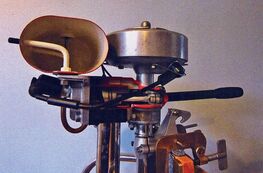DCA Members share their technical knowledge
One of the declared aims of the DCA is to support the sharing of information between members and, if possible, to assist members with technical advice on building, maintaining, modifying and sailing dinghies. Our Technical Advisor is always happy to help and members regularly write articles for the Journal , the best of which are often recognised with the Peter Bick Cup award. Much technical discussion takes place on the Forum or Facebook Page and always at our events and rallies as one member describes eloquently below:
Steve: The unique selling point of the DCA is its events. It's at the events that specialist knowledge is exchanged, either by admiring a home-built or extensively modified vessel being proudly explained by the owner, or around the camp fire over a beer and a BBQ dinner, or at an annual meeting. I believe that the members of the DCA are the most knowledgeable, experienced, inventive, creative, adventurous, interesting (I could keep going) collection of individuals with incredible specialist knowledge. The DCA brings specialists together. It gives a voice to and encourages the dissemination of expert information to other members. Easily overlooked from within, astonishing to view from outside.
Here is a selection of technical articles written by DCA Members and published in Dinghy Cruising:
|
Some Thoughts on Oars - and a little about rowing by Peter Bick with an addendum by John Rawson
DC 149 pp 30-31 and DC 150 pp 37 - 39 During this last twelve months I have had two enquiries from members about oars. Having had to research the matter fairly thoroughly it seemed to me that it would be a pity to waste this work. I have therefore collated my investigations with my own experience to produce this article. Read on... |
|
Length in Feet Equals Crew Weight in Stones by Keith Muscott DC 223 pp. 55-56 Keith examines the background and meaning of DCA Safety Recommendation 2.3 which states that the crew should be " Adequate for the dinghy: ideally one stone of crew weight for each foot of LWL (20kg/metre)". This idea originates from Allan Earl's book on Dinghy Cruising which was regarded as a 'bible' by early DCA members. Keith says: I believe there is nothing wrong with Earl's advice in the context from which he writes. Read on... |
|
Quetzal’s Conversion to Junk Rig by David Hall DC 236 pp. 52-54 At the end of the 2016 season I had used my boat very little and felt that perhaps I was losing interest in her. Each time I considered getting another boat, however, I realised that I was actually quite happy with her. A Westerly NIMROD is seaworthy, strongly built, has a cabin and a self-draining cockpit, so why would I wish to change her? Then I realised that I could actually make a big change, learn a lot along the way and give her a new lease of life by converting her to Junk Rig. Read on... |
|
Hoisting the Lugsail into the 21st Century by Roy Downes DC 219 pp. 36-44 Surprise was launched in 1973 as National 18 No. 303, with a conventional Bermudian sailplan, though with a lower aspect ratio than her racing sisters, as from the outset she was intended to be a cruising boat. ..... But an inescapable fact of dinghy cruising life is living with wet sails - in our case, a lot of them. The other downside for us was a more fundamental design problem: all our dry gear had to be stowed in the bow and stern tanks, precisely where one doesn't want weight in a small boat, and this gave us problems in heavy weather. ... After 10 years it was time for a rethink: one big sail with industrial reefs, a little mizzen for balance and gear stowage under the cockpit floor towards the centre of the hull. Read on... |
|
Backyard Boatbuilding: The Almost Classic Look by Tim Evans
DC 207 pp. 44-46 A couple of years ago I decided to build a rigid tender for use when my ‘ocean–going’ West Wight Potter was on a mooring. Like many people I have a particular liking for boats which look good as well as sail, so I tried to make the resulting dinghy as ‘boat-like’ as possible. I offer the following article to those readers who might be interested in how to build something similar that looks fairly traditional but which is strong and simple to construct. Using modern materials, particularly epoxy resin, it’s as easy to make a boat that looks and sails well as it is to make a floating packing case. Read on... |
|
Electric Bilge Pump For A Single-Handed Enterprise by Steve Bradwell
DC 228 p. 59 Sailing recently from Warsash (Hamble River) to Wootton Creek (Isle of Wight) in company with David Sumner in his Mirror dinghy led me to contemplate the amount of water that was coming aboard my International Enterprise. Wind was around force 6 and the steep Solent chop and broad reach was causing lots of spray as well as solid water from the occasional breaking wave to come aboard which eventually built up to a point that could no longer be ignored. Self-bailers were long ago removed from my boat and I am not tempted to fit new ones. Read on... |
|
Our Third Boat Trailer by John Perry
DC 228 pp. 56-58 Boats often last much longer than the road trailers made to transport them. Our home-made 15 foot sailing dinghy was completed in 1978 and it has now had three trailers made for it. The latest one, as shown in figure 1, was made a few years ago, the previous two trailers having both died from corrosion. My first requirement for a new trailer was that the frame at least would not come to a premature end due to corrosion. Read on... |
|
Learning to Love Lofting... or, The Joy of Boatbuilding from Scratch
by Bill Haylock DC 239 pp. 61-63 I’d like to encourage aspirant boatbuilders (particularly those, like me, on a limited budget) to consider the option of building a boat from plans, rather than from a kit. It is considerably cheaper and opens up a huge choice of designs to choose from. And, as I have found, it can make the build a much more rewarding and enjoyable activity in itself. I’m in the process of building a 16ft Apple lug yawl off plans I bought from the designer, Tom Dunderdale (of Campion Sail and Design – http://www.campionboats.co.uk/details.html) – for £73. Read on... |
|
Sectioning a British Seagull Outboard Motor by Andrew Dawson DC 230 pp. 58-60
Why spoil a perfectly good engine by cutting it almost down the middle? That is a question I heard frequently during the 10 months or so that this project occupied much of my time. The answer is quite simple. we take some of our outboards to displays of vintage transport and also give talks on the subject of older motors. To try and explain the workings of a two-stroke engine is difficult, particularly to folk without an engineering background. It therefore made sense to sacrifice an outboard to make such explanations easier. Read on... |
The friendly club with a sense of adventure. For all sailors who use boats for more than just racing.
|
© 2010-2024 DCA. All Rights Reserved. |
|










